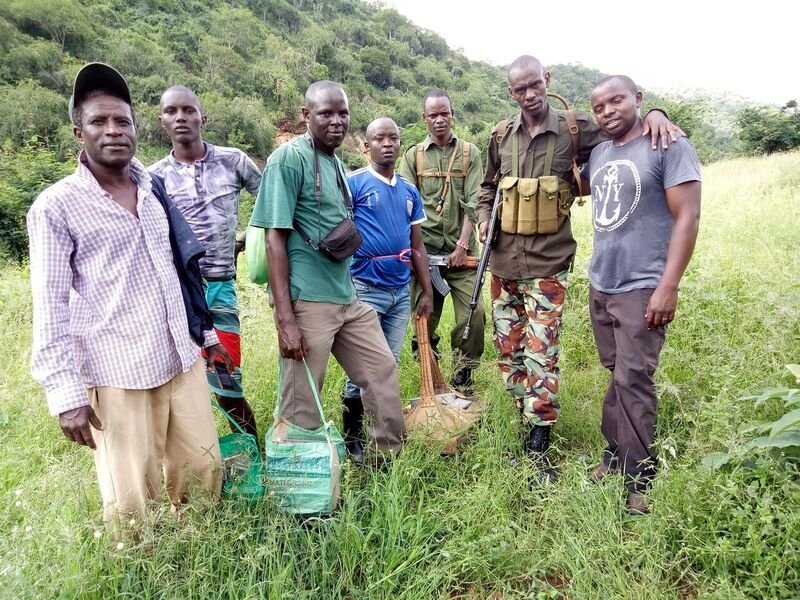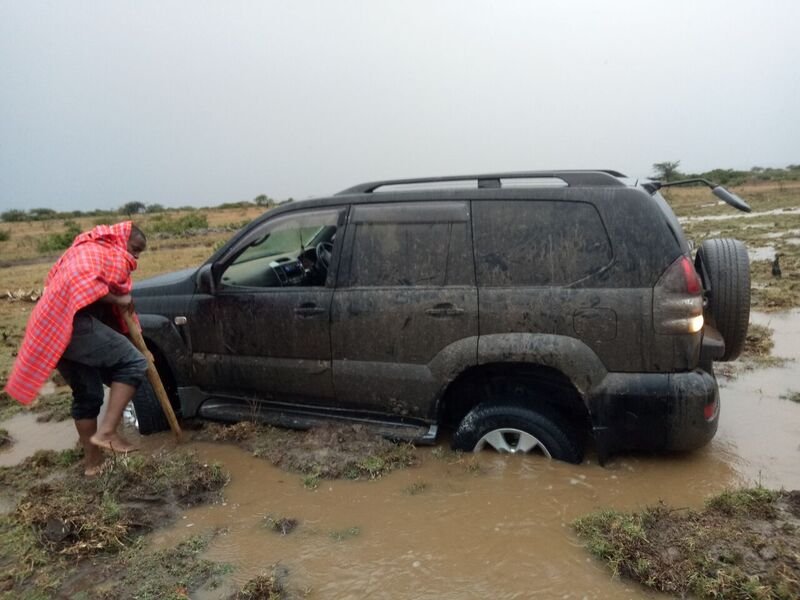Cycle 5 (2015 Deadline)
Remote sensing and GIS mapping for land use changes in Laikipia ecosystem, Kenya: a tool to explore patterns of biodiversity and emergence of vector-borne zoonoses and enhance environmental management and community health
PI: Nancy Moinde (nmoinde@gmail.com) Institute of Primate Research-National Museums of Kenya
U.S. Partner: Peter Leimbruger, Smithsonian Institution
Project Dates: December 2016 - October 2021
Project Overview:
 | | Mammal research team climbing the hills of Mukogondo forest, Photo credit: Dr. Moinde |  | | Challenges during reconnaissance surveys. Photo credit: Dr. Moinde |
Laikipia County in central Kenya supports one of the highest levels of mammalian diversity in East Africa. The semi-arid environment is changing rapidly due to land use changes, and climatic changes are projected to alter ecosystem resilience. These anthropogenic changes can alter the dynamics of zoonotic infectious diseases in wooded and bushland fringes of semi-arid ecosystems. Vector-borne diseases carried by vectors such as mosquitoes, ticks, and sand flies are known for their rapid response to environmental modifications and climate change.
In this PEER project, the team focused on the interrelationships between climate change, land use patterns and their impacts on large mammal distribution, and disease vector diversity. They studied how these, in turn, influence human adaptation and ecosystem resilience to ecological change. Using the Advanced Very High-Resolution Radiometer (AVHRR)-derived Normalized Difference Vegetation Index (NDVI), the researchers examined the relationship between inter-annual NDVI parameters and species richness of large mammals and ticks and sand flies as disease vectors. They also studied primary productivity of current land use systems within current climate patterns and its relationship to mammals and vegetation cover and variation in host feeding preferences of zoophilic mosquitoes, sand flies, and ticks from different land use systems and climatic zones of Laikipia. Dr. Moinde and her team used remotely-sensed data to represent environmental factors influencing species richness in different ecosystems, as well as disease vector sampling and molecular analysis of vector feeding preferences.
Final Summary of Project Activities
The PEER team conducted and analyzed a community questionnaire on perceptions of climate change in Laikipia County and its effect on their livelihoods, after which they correlated the survey findings with climate data analysis. The rainfall dataset indicated a shift towards a late start and early stop of seasonal rainfall, coupled with erratic distribution of the rains within the rain seasons and increased occurrence of heavy episodic rainfall events. Laikipia land users (i.e., farmers, agro-pastoralists, pastoralists, and commercial ranchers), expressed that the erratic nature of rainfall patterns in Laikipia have reduced livelihood production within the pastoralist, commercial rancher, agro-farmer, and farmer communities. The questionnaire dataset indicated the prevalence of various strategies like diversifying to two or more livelihood practices, which is becoming a mode of survival to mitigate vulnerabilities and increase resilience.
The researchers also held 10 community and stakeholder workshops, in which participants clearly articulated the link between extreme onset of episodic rainfall events and the relatively higher incidences of tick loads, which was also linked to corresponding increase of malaise symptoms similar to malaria and typhoid. The team collected blood samples from 570 individual mammals during the two-year data collection period, and their zoonosis data analysis indicated that the pathogens Rickettsia felis and Anaplasma p., found in small wild mammals, have symptoms that overlap widely with those of malaria and typhoid. Stakeholders also indicated that people within Laikipia County have access to clinics but are primarily only tested for the latter diseases. The key argument that came out of these workshops was that the public health authorities at the county level need to expand their clinical laboratory protocol to include other prevalent diseases identified in this study. These discussions also highlighted local mitigation strategies, such as applying marigold plants and hot chili peppers during the higher occurrences of tick load where goats are kept within certain sections of the rural Maasai households.
Research findings on small mammals also suggested that certain land use practices appear to impact mammal diversity and prevalence of zoonotic infection. The various datasets collected by the PEER team were integrated into an ecological model using binomial GLMM analysis to examine the interrelationship between climate and land use effects on small mammals and zoonotic disease. They found climate and land use can affect the prevalence of zoonotic diseases by conducting a conducive environment for pathogens, their vectors, and their reservoir’s host. Land use can in addition increase or decrease the interface for pathogen transmissions between different species. The team’s overall ecological model findings suggest that aridification and global warming due to climate change will increase zoonosis incidences as well as reduce species diversity and specifically evenness which can also increase incidences of zoonosis.
Publication
B.M.H. Wells, R.D. Crego, P. Chiyo, M. Otiende, I. Lekolool, G. Ouma, W. Gitau, S. Kivai, M. Jeneby, J. Stabach, P. Leimgruber, and N. Moinde. 2018. Management Regime Mediates the Precipitation-Vegetation Relationship in Rangelands: Implications for “Climate-Smart” Ecological Restoration Planning. 11th SER Europe 2018 Conference in Reykjavik, Iceland: Restoration in the Era of Climate Change, September 9-13, 2018.
Back to PEER Cycle 5 Grant Recipients
|





